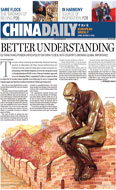Tradition
A crane flying toward the sun
Updated: 2011-05-03 07:54
By Cheng Anqi (China Daily)
For Beijing-based artist Li Wendi, birdwatching is not just a hobby but a way to get his creative juices flowing.
In the past three decades, he has spent most of his free time exploring the outskirts of the capital city to observe eagles, mandarin ducks, quails and jungle myna and sketch them.
|
Strong Wind, one of the representative flower-and-bird paintings of Li Wendi. Provided to China Daily |
"I can see birds in the city, but I feel more joy when observing them in the countryside," Li says. He recalls his trip to the outskirts of Beijing 30 years ago, which was the first time he saw mandarin ducks swimming in a river.
Li, 65, a prominent figure in the country's art scene, has earned acclaim for his depictions of eagles, other birds and landscapes. Eagles are one of Li's favorite subjects.
"For centuries, eagles have been regarded as a symbol of strength and are often depicted in Chinese paintings as heroes fighting in battle," Li explains.
Li says his eagle paintings are greatly influenced by the works of Li Kuchan (1899-1983), one of the best-known flower-and-bird painters in modern China.
In the 1970s, Li was taught by Kang Ning, a flower-and-bird painter and a student of Li Kuchan, and then went to a Beijing art school to further his studies while in his 50s.
Li captures the spirit of the subjects through expressive calligraphy brushwork and simplified forms, Kang says. "There's an energy in it."
He can finish a painting in 30 minutes, but can spend hours working on the minor details.
"He portrays birds, but he never ignores the surrounding scenery; he paints to show the happiness of birds and to illustrate the great harmony between the environment and animals," Kang says.
His pieces often depict traditional Chinese themes, such as waterfall scenes, birds in trees, and flowers, among other things.
"Focusing on the lives of birds, his paintings show his awareness and understanding of the relationship between life and nature," Kang says.
Li says representations of flowers and birds have different meanings. Mandarin ducks indicate pure love, while mynas express a happy-go-lucky lifestyle.
Cranes are symbols of longevity, while two cranes flying toward the sun means the wish to rise.
Geese signify married bliss, while quails and banana leaves represent peace and contentment.
E-paper

Head on
Chinese household care goods producers eye big cities, once stronghold of multinational players
Carving out a spot
Back onto center stage
The Chinese recipe
Specials

British Royal Wedding
Full coverage of the royal wedding of Prince William and Kate Middleton in London. Best wishes

The final frontier
Xinjiang is a mysterious land of extremes that never falls to fascinate.

Bridging the gap
Tsinghua University attracts a cohort of foreign students wanting to come to China.

